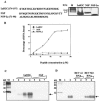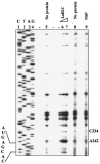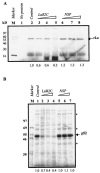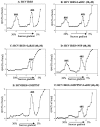A peptide derived from RNA recognition motif 2 of human la protein binds to hepatitis C virus internal ribosome entry site, prevents ribosomal assembly, and inhibits internal initiation of translation
- PMID: 16014945
- PMCID: PMC1181605
- DOI: 10.1128/JVI.79.15.9842-9853.2005
A peptide derived from RNA recognition motif 2 of human la protein binds to hepatitis C virus internal ribosome entry site, prevents ribosomal assembly, and inhibits internal initiation of translation
Abstract
Human La protein is known to interact with hepatitis C virus (HCV) internal ribosome entry site (IRES) and stimulate translation. Previously, we demonstrated that mutations within HCV SL IV lead to reduced binding to La-RNA recognition motif 2 (RRM2) and drastically affect HCV IRES-mediated translation. Also, the binding of La protein to SL IV of HCV IRES was shown to impart conformational alterations within the RNA so as to facilitate the formation of functional initiation complex. Here, we report that a synthetic peptide, LaR2C, derived from the C terminus of La-RRM2 competes with the binding of cellular La protein to the HCV IRES and acts as a dominant negative inhibitor of internal initiation of translation of HCV RNA. The peptide binds to the HCV IRES and inhibits the functional initiation complex formation. An Huh7 cell line constitutively expressing a bicistronic RNA in which both cap-dependent and HCV IRES-mediated translation can be easily assayed has been developed. The addition of purified TAT-LaR2C recombinant polypeptide that allows direct delivery of the peptide into the cells showed reduced expression of HCV IRES activity in this cell line. The study reveals valuable insights into the role of La protein in ribosome assembly at the HCV IRES and also provides the basis for targeting ribosome-HCV IRES interaction to design potent antiviral therapy.
Figures







Similar articles
-
Inhibition of internal ribosomal entry site-directed translation of HCV by recombinant IFN-alpha correlates with a reduced La protein.Hepatology. 2002 Jan;35(1):199-208. doi: 10.1053/jhep.2002.30202. Hepatology. 2002. PMID: 11786977
-
Structural determinant of human La protein critical for internal initiation of translation of hepatitis C virus RNA.J Virol. 2008 Dec;82(23):11927-38. doi: 10.1128/JVI.00924-08. Epub 2008 Oct 1. J Virol. 2008. PMID: 18829760 Free PMC article.
-
Human ribosomal protein L18a interacts with hepatitis C virus internal ribosome entry site.Arch Virol. 2006 Mar;151(3):509-24. doi: 10.1007/s00705-005-0642-6. Epub 2005 Sep 30. Arch Virol. 2006. PMID: 16195786
-
Targeting internal ribosome entry site (IRES)-mediated translation to block hepatitis C and other RNA viruses.FEMS Microbiol Lett. 2004 May 15;234(2):189-99. doi: 10.1016/j.femsle.2004.03.045. FEMS Microbiol Lett. 2004. PMID: 15135522 Review.
-
Mechanism of translation initiation on hepatitis C virus RNA.Princess Takamatsu Symp. 1995;25:111-9. Princess Takamatsu Symp. 1995. PMID: 8875615 Review.
Cited by
-
Hepatitis C virus translation inhibitors targeting the internal ribosomal entry site.J Med Chem. 2014 Mar 13;57(5):1694-707. doi: 10.1021/jm401312n. Epub 2013 Nov 5. J Med Chem. 2014. PMID: 24138284 Free PMC article. Review.
-
Enteroviruses: Classification, Diseases They Cause, and Approaches to Development of Antiviral Drugs.Biochemistry (Mosc). 2017 Dec;82(13):1615-1631. doi: 10.1134/S0006297917130041. Biochemistry (Mosc). 2017. PMID: 29523062 Free PMC article. Review.
-
Exploring Internal Ribosome Entry Sites as Therapeutic Targets.Front Oncol. 2015 Oct 20;5:233. doi: 10.3389/fonc.2015.00233. eCollection 2015. Front Oncol. 2015. PMID: 26539410 Free PMC article. Review.
-
Proanthocyanidin from blueberry leaves suppresses expression of subgenomic hepatitis C virus RNA.J Biol Chem. 2009 Aug 7;284(32):21165-76. doi: 10.1074/jbc.M109.004945. Epub 2009 Jun 16. J Biol Chem. 2009. PMID: 19531480 Free PMC article.
-
Specific sequence of a Beta turn in human la protein may contribute to species specificity of hepatitis C virus.J Virol. 2014 Apr;88(8):4319-27. doi: 10.1128/JVI.00049-14. Epub 2014 Jan 29. J Virol. 2014. PMID: 24478427 Free PMC article.
References
-
- Ali, N., G. J. M. Pruijn, D. J. Kenan, J. D. Keene, and A. Siddiqui. 2000. Human La antigen is required for the hepatitis C virus internal ribosome entry site-mediated translation. J. Biol. Chem. 275:27531-27540. - PubMed
-
- Bartenschlager, R. 1999. The NS3/4A proteinase of the hepatitis C virus: unravelling structure and function of an unusual enzyme and a prime target for antiviral therapy. J. Viral. Hepat. 6:165-181. - PubMed
-
- Becker-Hapak, M., S. S. McAllister, and S. F. Dowdy. 2001. TAT-mediated protein transduction into mammalian cells. Methods 24:247-256. - PubMed
Publication types
MeSH terms
Substances
LinkOut - more resources
Full Text Sources
Other Literature Sources
Miscellaneous

